Guide to attending a space launch in person
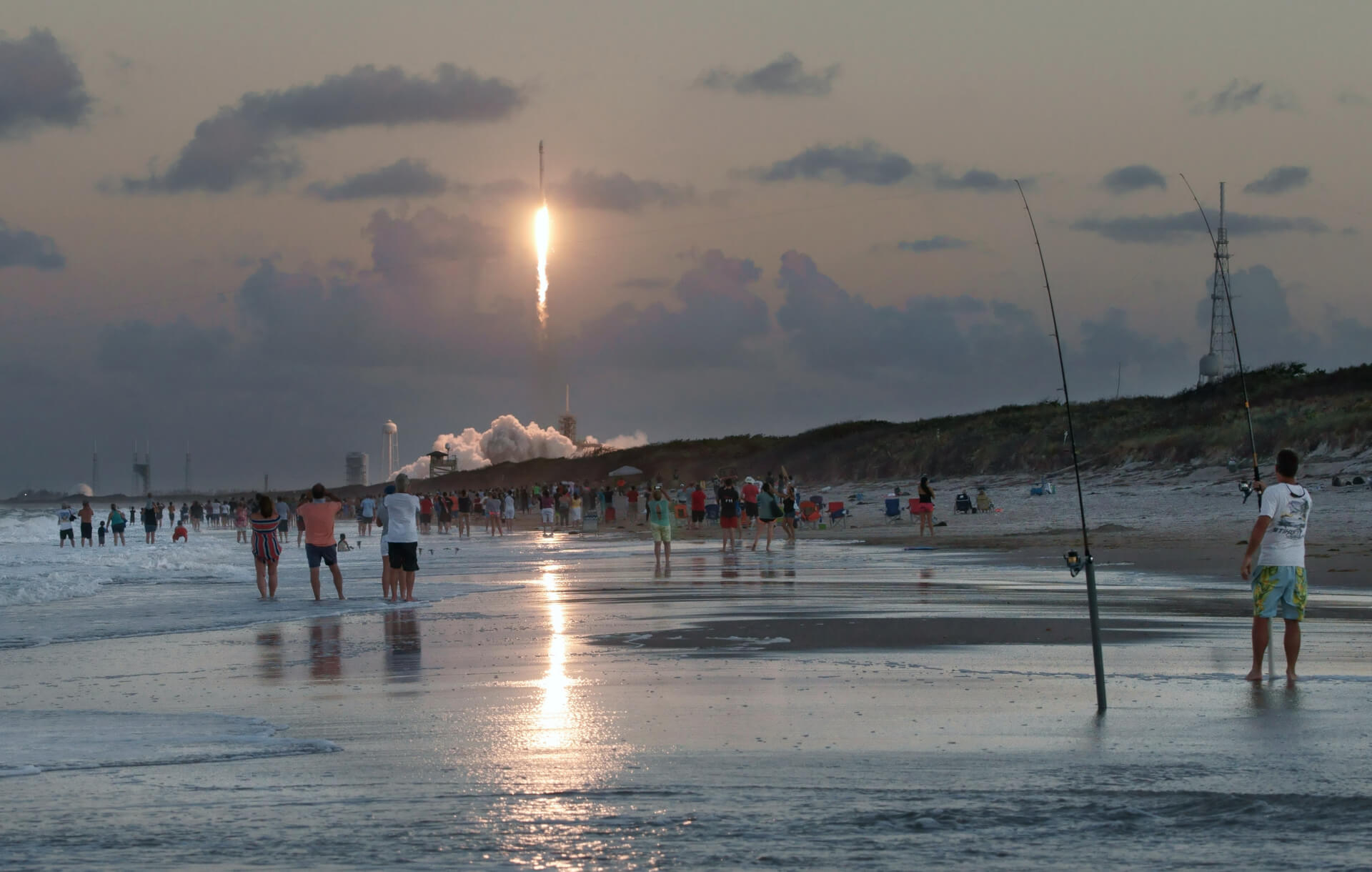
Image: Flickr / jillbazeley
A launch at Kennedy Space Center from Playalinda Beach with a telephoto lens
- Setting the scene
- Finding your nearest launch site
- Launch sites
- Summary Table
Kennedy Space Center / Cape Canaveral Space Force Station
Guiana Space Centre
Satish Dhawan Space Centre
SpaceX Starbase (Boca Chica)
Corn Ranch / Launch Site One
Onenui Station
Tanegashima Space Center
Wallops Island
Vandenberg Space Force Base
Andøya Spaceport
Uchinoura Space Center
- Wenchang, Xichang, Jiuquan and Taiyuan Space Launch Sites
- Baikonur, Vostochny and Plesetsk Cosmodromes
- Saxavord Spaceport and Sutherland Spaceport
- What are the most common rockets used today?
- Understanding launch schedules
- What does a typical day look like?
- Can I watch a livestream instead?
- Photographing a launch
- What are the different types of launches?
- What should I bring on the day?
- Frequently asked questions
Setting the scene
A great way to get a feel for what it's like to attend a launch is to watch someone vlog about their experience. For example this couple narrating their day at a SpaceX launch:
If going on a similar trip sounds good to you then read on.
Finding your nearest launch site
To begin with it's good to know which launch site nearest to you has upcoming launches.
Launch sites
Every launch site operates a bit differently. For most you'll need a ticket or reservation of some kind, others may let you just turn up while some may not be open to the public at all.
Here's a quick summary table of active orbital launch sites before we go into detail.
- Launch Site: Click the link to skip ahead for more info on that launch site.
- Official: Is there an official viewing area provided by the launch site operators?
- Unofficial: Are there publically accessible spots nearby with a good view?
- Next: Click the arrow to see the next scheduled launch at that launch site.
| Launch Site | Location | Official | Unofficial | Next |
|---|---|---|---|---|
| United States | ||||
| Kennedy Space Center | Florida | |||
| Cape Canaveral | Florida | |||
| SpaceX Starbase (Boca Chica) | Texas | |||
| Corn Ranch / Launch Site One | Texas | |||
| Wallops Island | Virginia | |||
| Vandenberg Space Force Base | California | |||
| Asia / Oceania | ||||
| Satish Dhawan Space Centre | India | |||
| Onenui Station | New Zealand | |||
| Tanegashima Space Center | Japan | |||
| Uchinoura Space Center | Japan | |||
| Wenchang Space Launch Site | China | [1] | ||
| Xichang Space Launch Site | China | [1] | ||
| Jiuquan Space Launch Site | China | [1] | ||
| Taiyuan Space Launch Site | China | [1] | ||
| Europe | ||||
| Guiana Space Centre | French Guiana | |||
| Baikonur Cosmodrome | Kazakhstan | |||
| Vostochniy Cosmodrome | Russia | |||
| Plesetsk Cosmodrome | Russia | |||
| Andøya Spaceport | Norway | [2] | [2] | |
| Saxavord Spaceport | United Kingdom | [2] | [2] | |
| Sutherland Spaceport | United Kingdom | [2] | [2] | |
[1]Chinese nationals only | ||||
[2]Newly established program or spaceport, public attendance policy is unclear | ||||
Launch site details
Kennedy Space Center / Cape Canaveral Space Force Station
Florida, United States
Launch site of the Apollo program, the Space Shuttle and countless other significant missions. This has been the primary launch site of NASA for more than 50 years.
Cape Canaveral is the adjacent United States Space Force base, used by Space Launch Delta 45 and their commercial partners.
If you're going to bucket-list one launch site it should be this one.
Organizations: NASA, United States Space Force, SpaceX, United Launch Alliance, Space Florida, Firefly Aerospace, Relativity Space, ABL Space Systems
Getting there
Your best option is Orlando International Airport. Melbourne Airport is closer but flights there are limited and often more expensive.
Rental car is easiest since there is no direct public transport to the center. From Orlando International Airport expect a roughly 60-75 minute drive, depending on traffic.
Private shuttle companies run direct round-trip services to the center for approximately $90, or you can take a public bus to Cocoa Beach and an uber or taxi the rest of the way.
Attending
TLDR: Best viewing location depends on which launchpad you're there to see, scroll below for more details. I've listed only the currently active pads. This list covers both Kennedy Space Center and Cape Canaveral.
- LC-37B (ULA): LC-39 Observation Gantry
- LC-39A (SpaceX): Playalinda Beach when open, otherwise Banana Creek
- LC-39B (NASA): Banana Creek
- LC-40 (SpaceX): LC-39 Observation Gantry
- LC-41 (ULA): LC-39 Observation Gantry
Kennedy Space Center has three official viewing locations, all bookable on their website.
Visitor Complex: The cheapest ticket, general admission will cost you $50. That gets you about 11.5 kilometers from all launchpads. It's ok but not great since direct line of sight to the launchpads is obscured by trees. Essentially you watch the jumbotron until ignition and then look up once the rocket clears the treeline.
LC-39 Observation Gantry: The closest official location to all the launchpads, from about 3.5 kilometers to LC-41 up to 9 kilometers to LC-37. Tickets will cost you $70 on top of the general admission price above. This building is closed to the public for launches on pad 39 since it's too near the launchpad.
Banana Creek at Apollo/Saturn V Center: Best view if you can't get tickets to the gantry. It's next to the Apollo/Saturn V Center and distances range from 6.5 kilometers to LC-39 up to 13 kilometers from LC-39. Access is via their $250 per person package. It's a hefty price tag but worth it for the good angle. This is the view seen in the video at the top of the guide.
Once in a blue moon they'll open up a VIP or personnel viewing area to the general public. I don't know what triggers this but when it happens the tickets go up on their website just like the other locations. This could be the East NASA Causeway or the holy grail, the ITL Causeway. If you see these take them, you'll get a better view there than anywhere else.
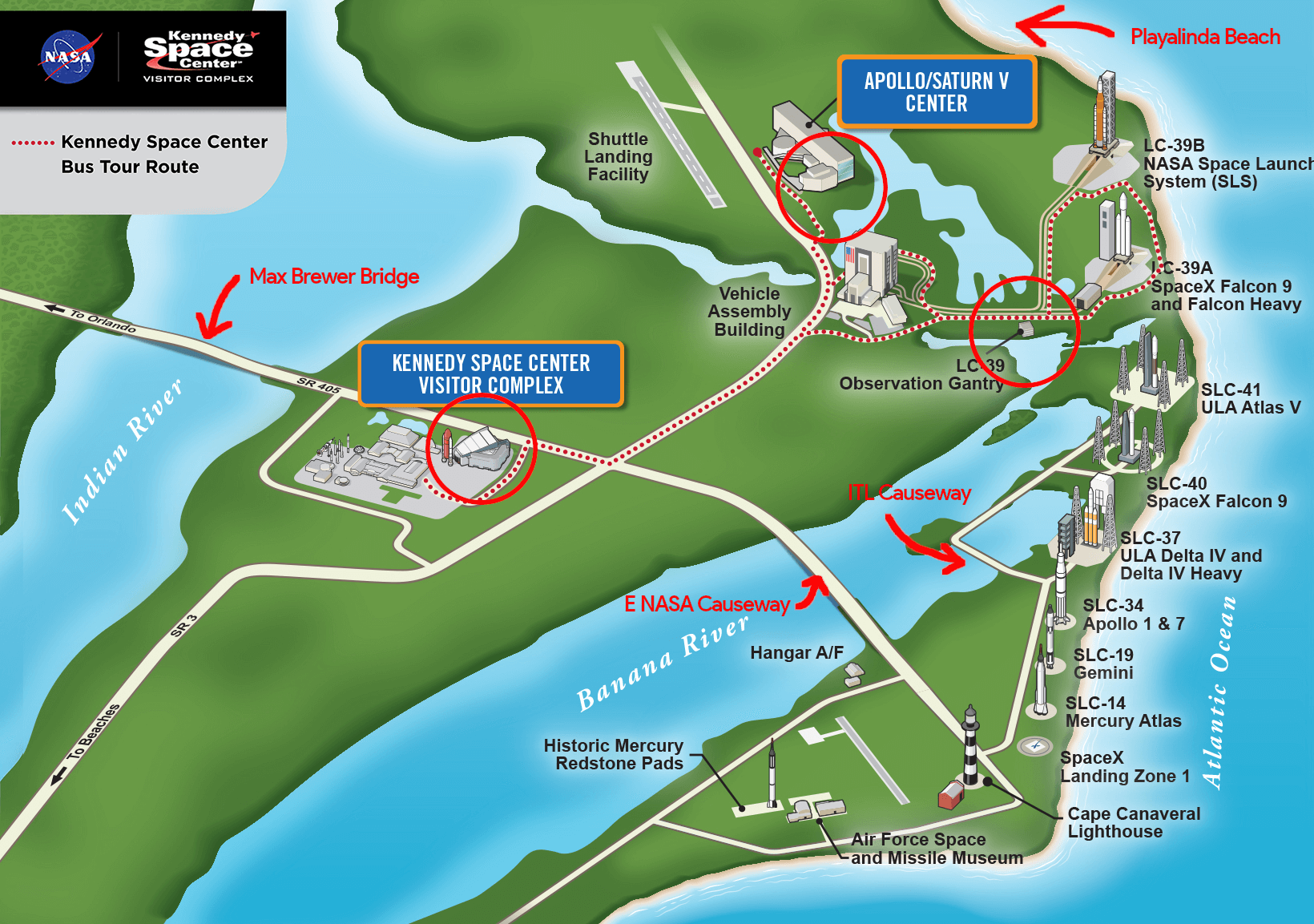
All options (except the causeways) have a jumbotron and live commentary. Tickets can in theory be purchased on the day but will be sold out well before launch. The gantry in particular will sell out within a few hours.
There are also good views from public locations near the launch site.
Playalinda Beach: For LC-39A since the gantry is closed this is closer than any official location at 5 kilometers. For LC-39B the beach will always be closed since it's too close. For all other pads it's the best public spot. Unfortunately it's often closed without warning on launch day at the agency's discretion. Normal hours are 6am to 8pm. Note that parking at the first lot will likely fill up but if you keep driving north there are additional lots. Just a word of warning at the northern-most section it becomes a nudist beach ("pier 13", near the 13th parking lot).
The view in the photo at the very top of this guide is Playalinda Beach.
Max Brewer Bridge: About 18 kilometers away from LC-39 and a bit more from the others. A slightly better view of the northern launchpads than the visitors complex. When Playalinda Beach is closed this is probably your best bet for a free and public viewing spot.
KARS Park: This is a NASA-owned park on Merritt Island that has recently (late 2023) begun allowing non-NASA visitors in on launch day for $5. This has good views of all the launchpads except LC-39. If this spot gets too popular I suspect they will again restrict it to employees only so I will not recommend it but you can check their facebook for more.
Note: You may hear some conflicting information from previous attendees about Port Canaveral being the best public location. The spot that they're referring to (the bleachers on route 401) was closed to the public in 2023 due to traffic concerns.
Parking
Parking available on-site, including for RVs.Guiana Space Centre
French Guiana
Known as "Europe's Spaceport". Primary launch site of ESA and CNES. Lies just above the equator and hosts Ariane, Soyuz and Vega launches.
Organizations: ESA, Arianespace, ROSCOSMOS, CNES
Getting there
The closest commercial airport is Cayenne – Félix Eboué Airport in Matoury.
From the airport a 1-hour drive in a rental car will get you to Guiana Space Centre.
Attending
Attendance is possible by booking online here with site owner CNES. There is no fee for attending a launch here and your booking will include a guided tour in French or English.
Children under 16 are not allowed within 6 kilometers of the launchpad. Children under 12 are not allowed in the control center. Children under 8 are not allowed on the spaceport grounds at all. Check with them when booking since this may vary.
You will receive assembly instructions in your booking confirmation. There a group tour bus will pick you up and take you to some of the more interesting parts of the space center, before ending up at the viewing area to see the launch.
At booking time you will be able to choose a viewing location. Agami is the closest option.
On the map the launchpads are marked D, E and F and the viewing areas are circled.

Agami: 7 kilometers from Ariane and Vega. Ages 16+.
Ibis: 13 kilometers from Ariane and Vega. Ages 8+
Toucan, Colibri: VIP locations. You'll need to know someone or get lucky when they open it up to the public. Toucan is open for Ariane and Soyuz, Colibri is open for Soyuz.
Jupiter: The control center. Another VIP area but may be open to the public based on attendance numbers, you can enquire when booking. This is a really unique experience watching a real mission control center in operation. You'll have a better time if you speak French.
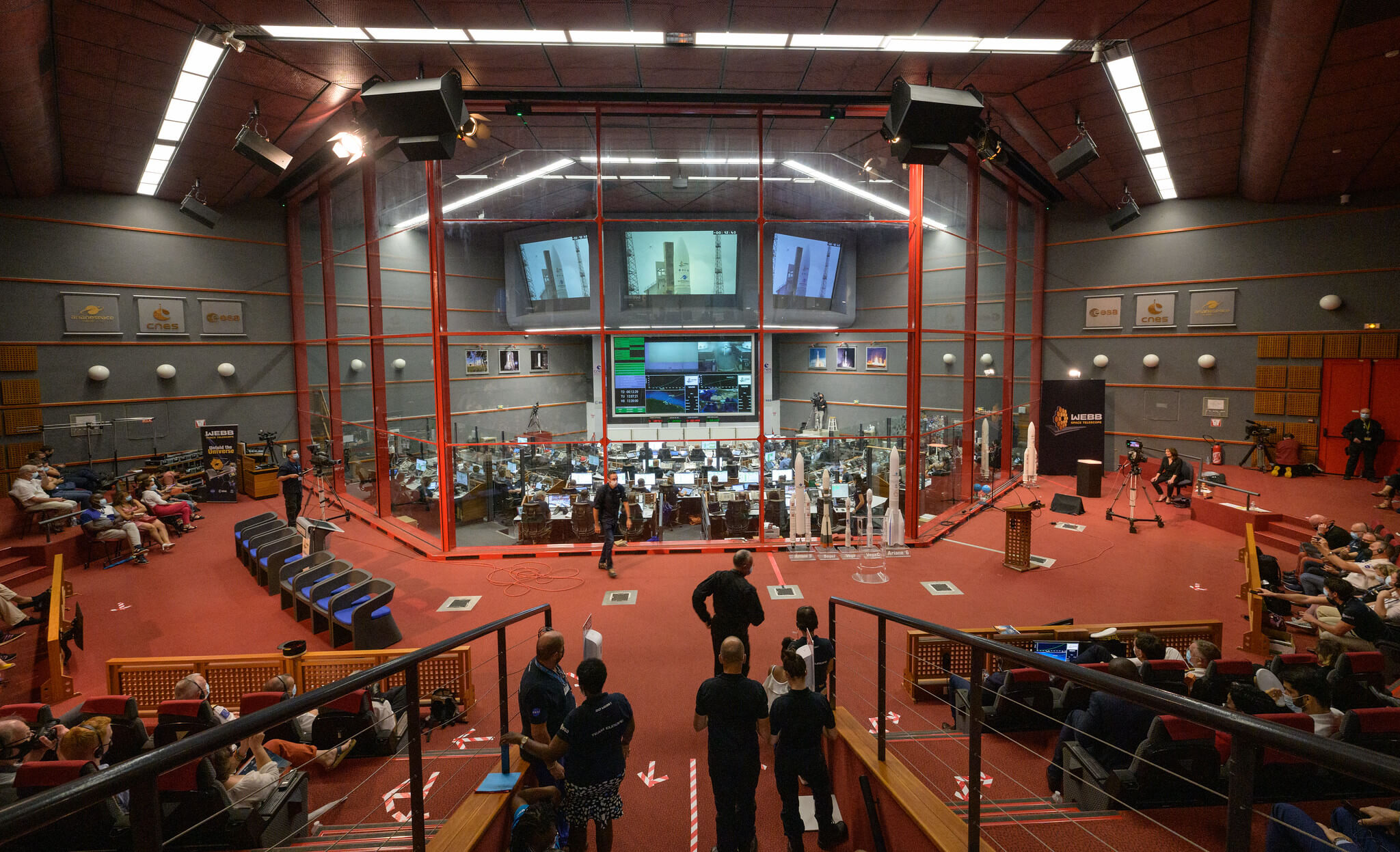
Image: Flickr / nasawebbtelescope
For those without a booking or with children under 8 we recommend:
Carapa Observation Deck: On a high hill overlooking the launch site. 13 kilometers away. There'll be ESA staff there handing out information and a live feed on a screen.
Parking
Parking available on-site.Satish Dhawan Space Centre
Andhra Pradesh, India
Primary launch site of ISRO, known for its joint discovery with NASA of water molecules on the Lunar surface and for their Mars Orbiter Mission.
Organizations: ISRO
Getting there
The closest commercial airport is Chennai International Airport in Chennai.
A 3-hour drive from the airport in a rental car will get you to Satish Dhawan Space Centre.
Alternatively a bus can be taken from the airport to Sullurpeta, and from there a taxi or other local transport option can take you 1 hour to the center.
Attending
The on-site launch view gallery is accessible by applying for a pass on the ISRO website. Booking is free and is allocated on a first-come-first-served basis. The booking website is only online during the registration window.
On launch day you won't be allowed on Sriharikota without a valid pass.
Launch View Gallery: 7 kilometers away, capacity of 5000. It has tiered seating like a sports stadium. Has a jumbotron. Right next to the space museum. Not covered so for daytime launches it gets crazy hot and you'll need an umbrella.

For those without a pass there is a good view of the launch from Venadu Road near Pullicat Lake. In summer the lakebed dries up and you can walk onto it for a slightly better view.
Venadu Road: 12 kilometers away. Near the first security checkpoint at Attakanitippa.
Parking
Parking available on-site.SpaceX Starbase (Boca Chica)
Texas, United States
Launch site of Starship, the largest rocket ever built.
Organizations: SpaceX
Getting there
The closest commercial airport is Brownsville-South Padre Island International Airport in Brownsville.
From the airport it's a 30-minute drive to the base.
Attending
A large exclusion zone around the launch site is in effect on launch day, only accessible by site personnel. Isla Blanca Park is the most commonly recommended viewing location. It's just outside the exclusion zone.
Isla Blanca Park: 5 kilometers from the launch pad.
On the map the highlighted red area shows the boundaries.
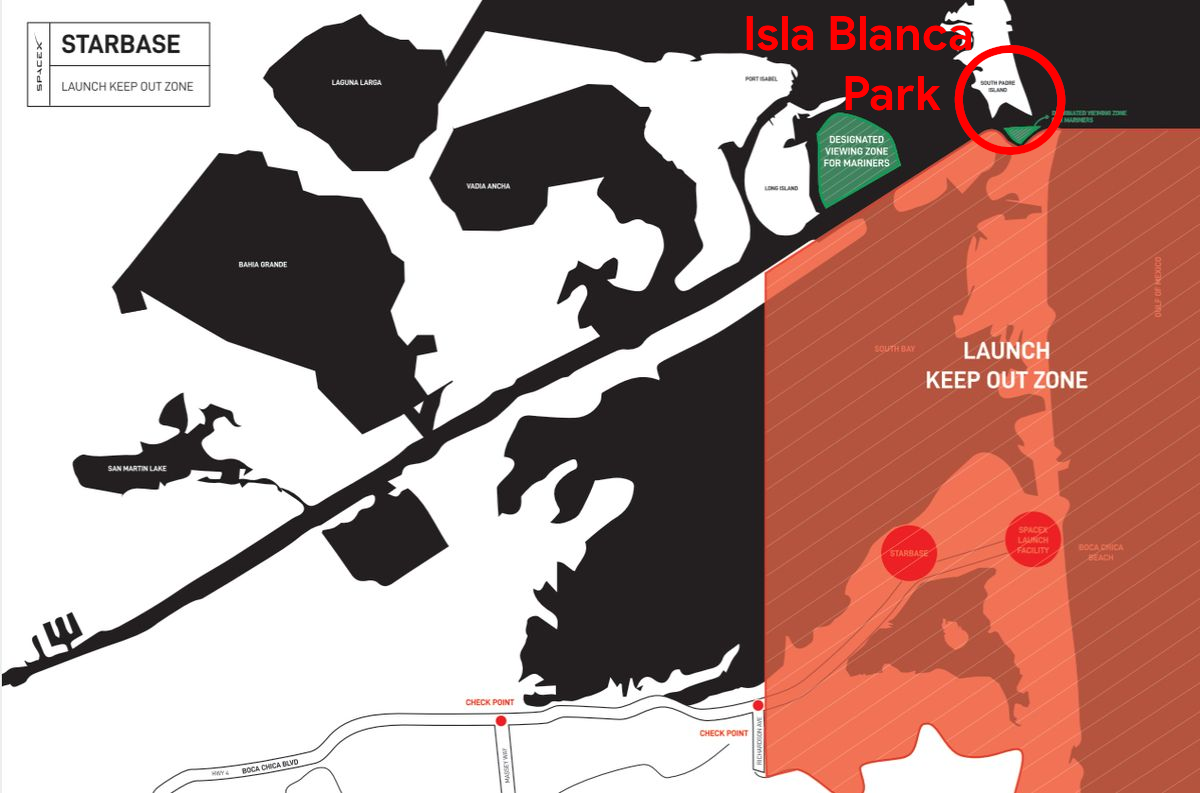
Image: SpaceX
On the southern edge of the exclusion zone you'll notice a non-excluded part that's closer to the launchpad. That's the other side of the Mexican border. There may be good viewing locations from there but I've heard it's not safe, you'd need to research that on your own.
Parking
Parking available on-site but not on launch day.Corn Ranch / Launch Site One
Texas, United States
Home of Blue Origin and their New Shepard program, which aims to carry passengers and payloads on suborbital flights for commercial or tourism purposes.
Organizations: Blue Origin
Getting there
The closest commercial airport is El Paso International Airport in El Paso, Texas.
Driving from the airport it'll take 2 hours to get to nearby Van Horn and then a further 30 minutes to Corn Ranch.
Attending
Not open to the public. Blue Origin advise that they do not recommend people try to view their launches in person. Road closures by local law enforcement are used to eliminate potential viewing areas. The closest point on nearby Highway 54 is about 8 kilometers from the launch pad but it's difficult to say how much of the road will be closed on launch day.
Parking
Parking not available on-site.Onenui Station
Mahia Peninsula, New Zealand
The first private launch facility to make an orbital launch. Owned and operated by Rocket Lab whose goal is to launch light payloads at a frequent cadence.
Organizations: Rocket Lab
Getting there
The closest airport is Hawke's Bay Airport (aka Napier Airport) in Napier. From the airport take a rental car 3 hours north to Māhia. Alternatively take a bus to Māhia Peninsula and a taxi the rest of the way. Buses are infrequent in this area as it is mostly rural.
Note that Onenui Station is private property and does not allow general access to the public.
Attending
Viewing from the launch site is restricted to site personnel. All areas on the peninsula with a view of the launch are typically closed off on launch day. As such there are usually no publically-accessible spots to view launches at Onenui Station.
This may change in the future as Rocket Lab's commercial operations ramp up.
Parking
Parking not available on-site.Tanegashima Space Center
Kagoshima, Japan
The larger of JAXA's two spaceports on Kyushu Island. They launch their more powerful rockets here, namely the H-IIA and H-IIB, as well as cargo missions to the ISS.
Organizations: JAXA, Mitsubishi Heavy Industries
Getting there
The closest commercial airport is Tanegashima Airport in Tanegashima. Fly to Kagoshima Airport and then take a domestic flight to Tanegashima or take a 4-hour ferry (or 2-hour high-speed boat) from Kagoshima Port.
Driving from Tanegashima's airport or port to the space center will take you about an hour.
Attending
The space center is closed on launch day as well as a 3-kilometer radius around it. Rocket Hill Observatory is closed on launch days since it is within the radius.
There are several good public locations outside the 3-kilometer radius.
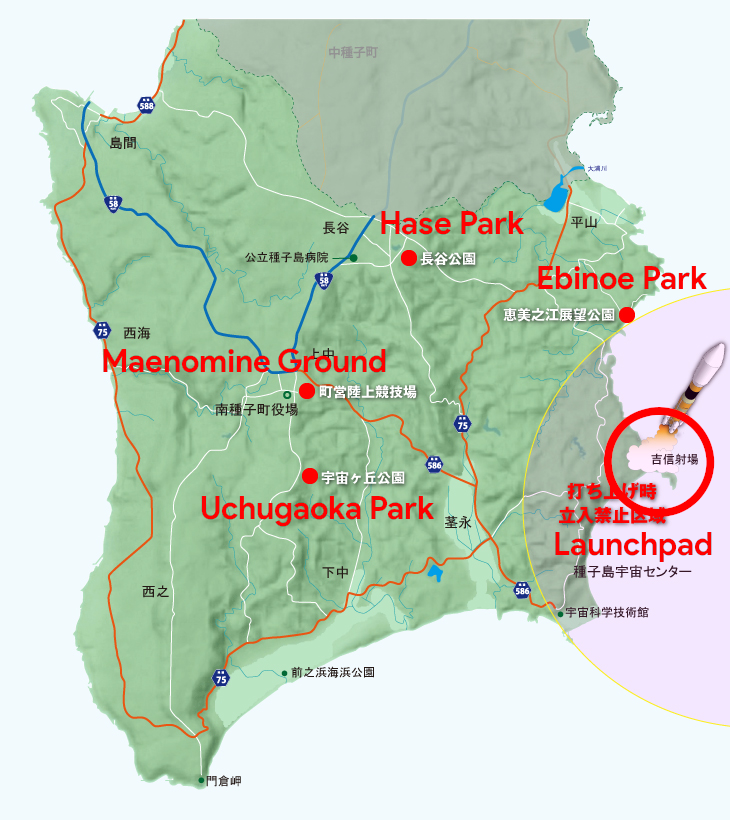
Image: minamitane.kagoshima.jp
Eminokotenbo (Ebinoe) Park: The closest observation point at just over 3 kilometers. A lottery system determines who is allowed into the park for the launch.
Hasetenbo (Hase) Park: About 6 kilometers distance. Minamitane town's recommended viewing area. Unrestricted entry.
Uchugaoka Park: About 7 kilometers distance. You'll need to be on the raised observation deck to get a view of the launchpad.
Maenomine Ground: This is on JAXA's list of observation points but I can't find much info on it. It's a small athletics track near the city center.
Parking
Parking available on-site.Wallops Island
Virginia, United States
The Mid-Atlantic Regional Spaceport is NASA's east coast facility. Known for its suborbital sounding rockets and for hosting Northrop Grumman's Antares launches.
Organizations: NASA, Northrop Grumman
Getting there
The closest commercial airport is Salisbury-Ocean City Wicomico Regional Airport in Salisbury, Maryland.
A 1-hour drive by rental car southeast will end at Wallops Island.
Attending
Launches can be viewed 12 kilometers away at NASA's visitor center for no cost. It has an excellent view and it's free but unfortunately entry isn't guaranteed since they don't offer bookings ahead of time. It's first-come-first-served at the door so come an hour early. It's only available as an option for daytime launches within their regular business hours.
This image shows NASA's recommended viewing areas, I've circled in pink my recommendations, scroll below for more details.
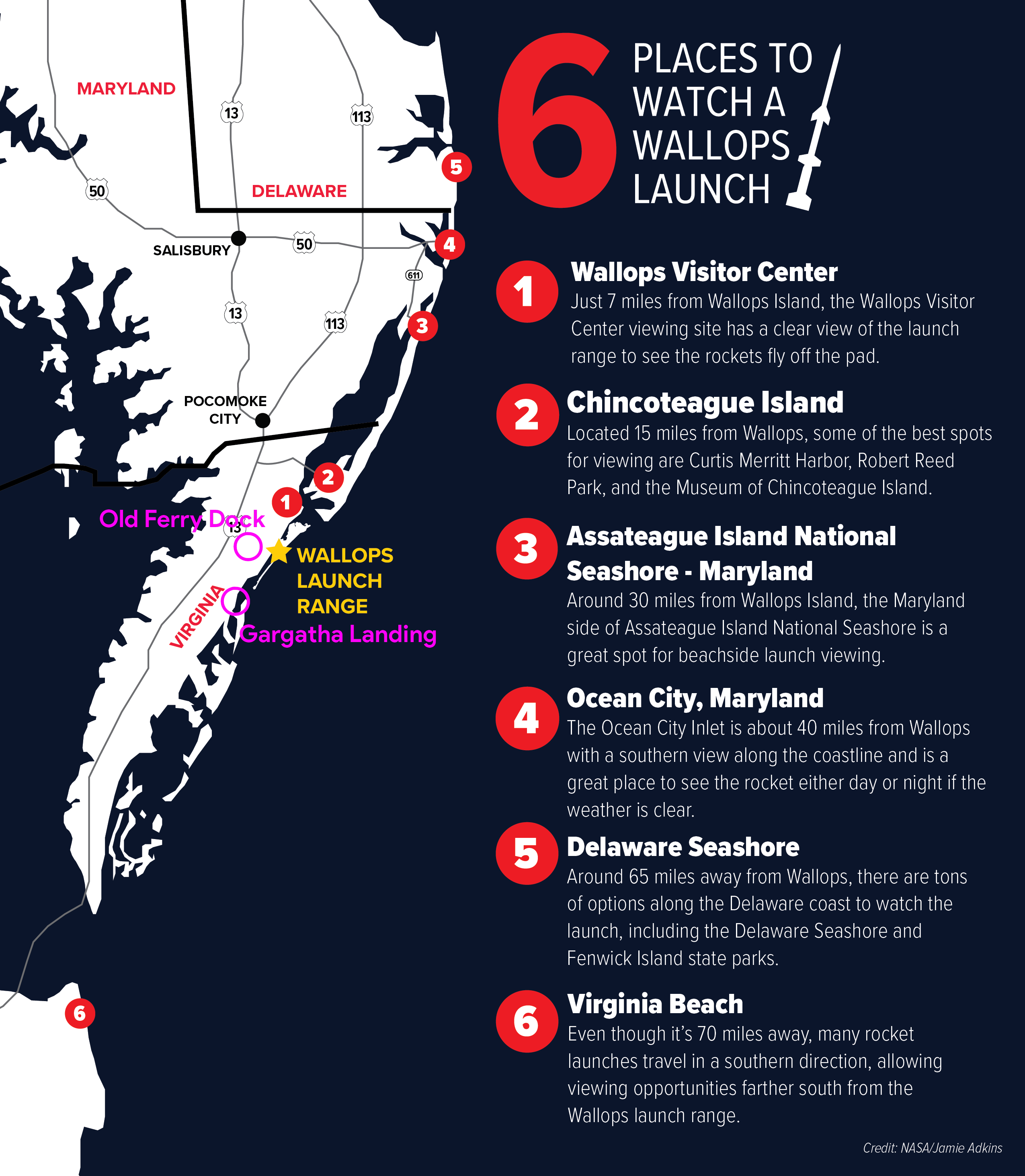
Image: NASA/Jamie Adkins
There are public spots available that are actually closer to the launchpads than the visitor center. The best alternative was previously Arbuckle Neck Road but that's been closed for safety reasons. Best now would probably be:
Old Wallops Island Ferry Dock: Closest public spot, about 4 kilometers from the launchpad (compared to 12 kilometers for their visitor center).
Gargatha Landing: 9 kilometers from the launchpad. A quieter spot.
Parking
Parking available on-site.Vandenberg Space Force Base
California, United States
Owned and operated by the United States Space Force, Vandenberg is known for its ideal location for polar and sun-synchronous orbit launches and heavy commercial utilization.
Organizations: United States Space Force, NASA, SpaceX, United Launch Alliance, Northrop Grumman, Firefly Aerospace, Rocket Lab, some international agencies
Getting there
Rental car is easiest. Vandenberg Space Force Base is approximately 2.5-hours drive northwest of Los Angeles International Airport or 4 hours drive south of San Francisco International Airport. Note that although Vandenberg Space Force Base hosts commercial space launches it is primarily a military base and public access is limited.
Attending
Viewing from the launch site is restricted to military and base personnel.
Public locations around the base provide excellent views, depending on weather.
Surf Beach: Best option for all launchpads if the marine layer keeps west, otherwise you'll get a poor view. Fills up fast on launch day. Closed from March to September to protect local wildlife and in the other months it'll sometimes be closed depending on launch trajectory.
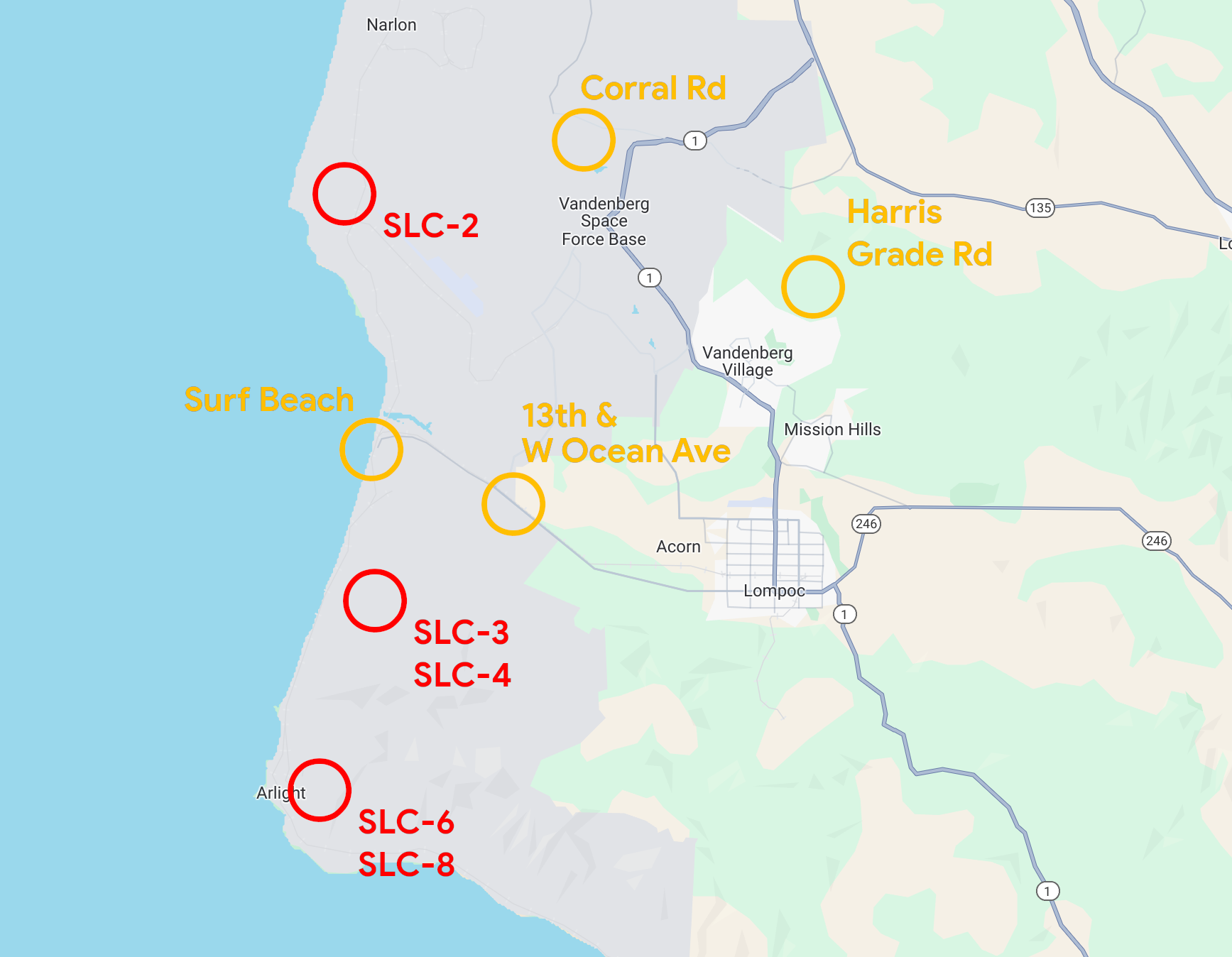
Corral Road: Good option for SLC-2. The semi-official viewing area. 8 kilometers away.
13th & W Ocean Ave: Good option for the southern pads. The hills and marine layer obstruct your view a bit but this is the closest you'll get, it's just outside the security checkpoint. There are a few other good intersections along W Ocean Ave (notably Renwick & W Ocean Ave).
Harris Grade Road: Alternative angle for all pads. It's up high on a hill and above the marine layer so you'll always have a view but it's much further away at 17 kilometers.
Parking
Parking available at the visitor center.Andøya Spaceport
Andenes, Norway
Launch site of sounding rockets since 1962, Andøya Spaceport is located above the arctic circle and has recently begun launching orbital rockets, specializing in polar orbits.
Organizations: Andøya Space, Isar Aerospace
Getting there
The closest commercial airport is Harstad/Narvik Airport in Evenes.
Taking a rental car from the airport will get you to the spaceport in about 3 hours.
Alternatively buses can be taken across Andøy, although this option will take you closer to 7 hours and will require several transfers.
Attending
Their orbital launch programs are somewhat new, I don't have information about how to attend a launch in person at Andøya.
Parking
Parking available on-site.Uchinoura Space Center
Kagoshima, Japan
The smaller of JAXA's two spaceports on Kyushu Island. They launch their smaller rockets and scientific payloads here. Less remote than Tanegashima.
Organizations: JAXA
Getting there
The closest commercial airport is Kagoshima Airport in Kagoshima.
You can rent a car from the airport and take a 3-hour drive to Uchinoura Space Center.
Attending
Attendance on launch day is via lottery on the Kimotsuki Town homepage.
Parking
Parking available on-site.People's Republic of China
Chinese spaceports are generally closed to foreigners so I don't have much information, please reach out if you know more. For Chinese citizens a permit can be booked with CASC for a fee, typically around $20 USD.
Russian Federation and Kazakhstan
Traveling to Russia is not recommended at the moment due to the ongoing war in Ukraine.
Paid guided tours are normally how foreigners access Russian cosmodromes, for example Russia Discovery or Star City Tours, at a cost of around 3000 USD.
If you only plan on seeing one then Vostochny is the most modern and likely the heart of Russian spaceflight moving forward. Alternatively Baikonur is dripping in history as the launch place of the first human in space (Yuri Gagarin).
United Kingdom
These newly built British spaceports have not yet released information on how the public can attend a launch. Please let me know if you have more details.
What are the most common rockets used today?
Number of launches in the most recently completed calendar year:
90 or more launches
- SpaceX: Falcon 9
20 or more launches
- CNSA/CASC: Long March 2
5-10 launches
- Rocket Lab: Electron
- CNSA/CASC: Long March 3
- CNSA/CASC: Long March 4
- Galactic Energy: Ceres-1
- CNSA/CASC: Kuaizhou-1A
- ROSCOSMOS: Soyuz 2.1a
- ROSCOSMOS: Soyuz 2.1b
Less than 5 launches
- SpaceX: Falcon Heavy
- North Korea: Chollima-1
- CNSA/CASC: Long March 7
- ISRO: GSLV
- JAXA: H-II A
- ROSCOSMOS: Soyuz 2.1v
- i-Space: Hyperbola-1
- Arianespace: Ariane 5
- United Launch Alliance: Atlas V
- ISRO: PSLV
- Firefly Aerospace: Firefly Alpha
- Khrunichev: Proton
- SpaceX: Starship
- Plus a long tail of rockets with a single launch
Note: The landscape changes every year and the same list for 2024 is already looking very different. For example, United Launch Alliance's Atlas V is being phased out over 2024 and 2025 in favor of Vulcan.
Understanding launch schedules
If you take only one tip away from this guide make it this: have a backup plan in case the launch you attend is rescheduled ("scrubbed").
Of the 135 scheduled launches of NASA's Space Shuttle between 1981 and 2011 there were 121 scrubs all up, an average of almost 1 scrub per launch. Launching a rocket is hard. Space flight pushes the boundaries of what is technologically possible and that's compounded by the unpredictability of the weather. You're going to have a bad time if you put all your eggs in a single launch day basket.
What happens when a launch is scrubbed?
Launch providers will always err on the side of caution when determining whether or not to go ahead with a launch. A launch could be scrubbed for any number of reasons but it's almost always weather related or a mechanical concern. Sometimes it'll be scrubbed seconds from launch. The new date selected could be the next day or it could be months later, depending on the circumstances.
A practical concern you'll have is what happens to your ticket if the launch is scrubbed. While it does depend scrub policies are generally written to favor the organization over the customer. For example a Kennedy Space Center package will give you one "do-over", where the first time a launch is scrubbed your ticket updates to the new date but if it's scrubbed a second time then your ticket is null and void, no refunds issued. This is an unavoidable fact when attending a launch in person and you need to factor that into your plans.
How accurate are the schedules?
A launch window is the time period within which the launch must go ahead for the rocket to reach its intended orbit or destination. It could be anywhere from a single moment ("instantaneous launch window") to a few hours long. You'll need to treat the published time as a best-guess approximation only, the launch could happen at any time in the window.
A typical day attending a launch
Let's assume you're attending a midday launch at Kennedy Space Center.
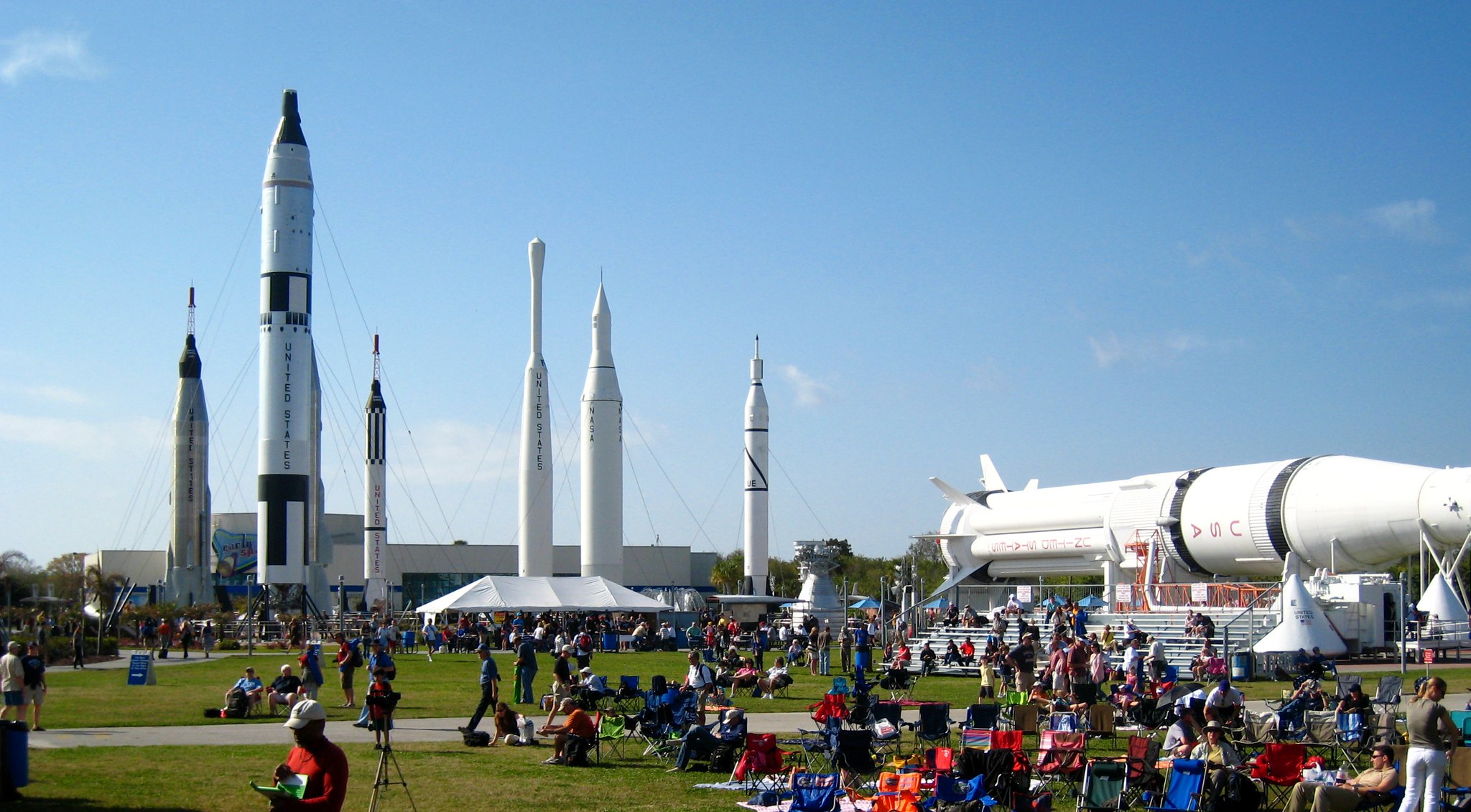
Image: Flickr / john_stockton
Early Morning
Arrival and Check-In: Arrive at the center a few hours before launch. Quick selfie at the NASA meatball out front and then queue at the front gate. Go through the security checkpoint.
See the sights: Visit the Atlantis exhibit and see the Rocket Garden. Fuel up at the cafe.
Late morning
Shuttle bus: Board the shuttle bus to your designated launch viewing area.
Settle in: Get out your chairs, blankets and any other comfort items.
Waiting
Relax and prepare: Enjoy the atmosphere and chat with fellow enthusiasts. Keep an ear out for loudspeaker announcements and check the official Twitter feeds.
Patience required: Your launch may be delayed from its scheduled time. This is very normal.
Final preparation: About an hour before launch final checks will begin. Listen to the launch commentary to follow along.
Launch
Final countdown: In the last few minutes the excitement peaks. Many people will count down along with the official countdown.
Launch: The ground will begin to shake and you'll feel it all the way up to your chest. We have lift-off. Expect cheers from the crowd.
Post-launch
Shuttle back: Your shuttle will return you to the Visitor Complex where you can then take your time exploring the rest of the exhibits or drive home.
Expect traffic: Just like heading home from a concert or sporting event the roads will be extremely busy until you clear the area. Allow extra travel time.
Can I watch a livestream instead?
Sure, most major providers stream their more significant launches. You can check them all in one place at spacetv.net. They aggregate all the publically available streams. Alternatively check the official website or channel directly for any launches you're interested in.
- NASA: nasa.gov
- ESA: esa.int
- SpaceX: x.com
- Rocket Lab: rocketlabusa.com
- Arianespace: youtube.com
- ISRO: youtube.com
- ROSCOSMOS: youtube.com
- CNSA/CASC: youtube.com
- Blue Origin: youtube.com
- JAXA: nicovideo.jp
For an example of what to expect in a livestream here's Rocket Lab's recent Ready, Aim, PREFIRE launch in collaboration with NASA.
Photographing a launch
Good photography at a launch is tricky given the distance involved and the many unknowns. I'm no professional but you can find tips from one at Scriptunas Images by Walter Scriptunas II. You'll find a few examples of his amazing work on his homepage.
What are the different types of launches?
Orbital launch: Rocket is aiming to achieve orbit. Used for satellites and missions to the ISS. Example: Falcon 9, Long March 7, Soyuz 2.1a.
Suborbital launch: Rocket is aiming to get to space but not achieve orbit. Used for scientific missions or space tourism. Example: New Shepard.
Air launch: Rocket is carried into the atmosphere by a conventional aircraft where it will then begin an orbital or suborbital launch. More fuel efficient than a ground launch but only viable for lighter rockets. Example: Pegasus.
Sea launch: Rocket uses a mobile maritime launch platform for orbital or suborbital launches. This can get you closer to the equator and allows a safer flight path. Example: Ceres-1S.
We can also make a distinction between crewed and uncrewed launches. Most launches are uncrewed but SpaceX's Crew Dragon and Blue Origin's New Shepard launch several times per year and Boeing will begin crewed launches in 2025 on Starliner with NASA.
What should I bring on the day?
Some essentials will be purchasable near the launch site but usually fairly highly marked up. Stock up before you head out.
Frequently asked questions
Anything that doesn't fall under an above section.
Is there a lower commitment alternative to attending a launch?
The International Space Station is visible to the naked eye or under telescope and offers a fun observation experience without having to travel. When it will be visible for you can be tracked at james.darpinian.com, along with other satellites like Tiangong.
Where do you source the launch data?
There are lots of websites like this one but we're mostly all just wrappers around Launch Library 2, a free and public API from The Space Devs. They're the real heroes. They track all orbital launches and all significant suborbital launches.
Where can I connect with other enthusiasts?
Reddit is a good option, try r/space and r/spaceflight. Another big option is the nasaspaceflight.com forum (not affiliated with NASA).
Got any book recommendations?
For a reasonably technical reader get The Case for Space by aerospace engineer Robert Zubrin. You'll get context on the recent commercialization of spaceflight, explore what is technologically possible in the near-term and find a roadmap for humanity's progression to a space-faring, space-exploiting galactic civilization. A little bit math heavy but it's mostly just proofs. The back half of the book lays out coherent scientific and philosophical arguments as to why we bother with space exploration in the first place.
Still technical but a touch more accessible is Apollo 13 by NASA astronaut Jim Lovell. You may have seen the Tom Hanks adaptation. The gripping account of the oxygen tank explosion aboard Apollo 13 and the heroic efforts by both Houston and the crew to get them home safe, written by the mission commander. Does a great job capturing the ingenuity and teamwork that exemplified the space race.
If you're just after a good time then The Martian by Andy Weir deserves all the love that it gets. An excellent mix of science, humor, action and potatoes.
Any other general tips?
- Hydrate. You could be waiting for hours.
- If you plan on parking then get there early.
- Scout for bathrooms before you need one.
- Sunscreen. Most outdoor viewing areas don't have any shade.
- Plan for poor or nonexistent cell service.
Helpful links